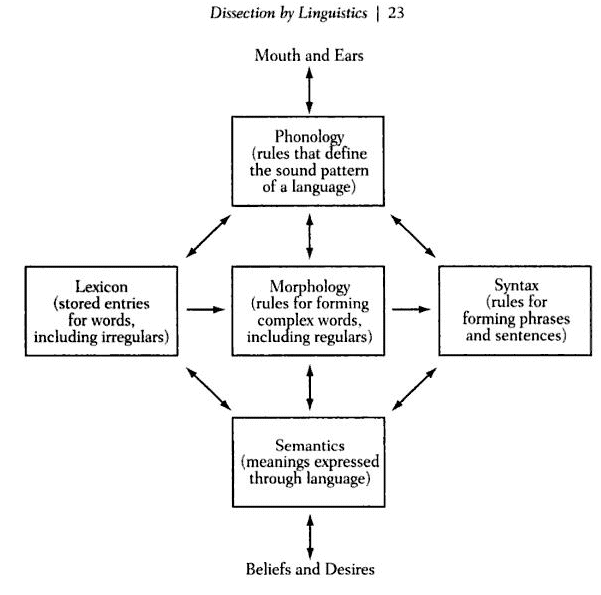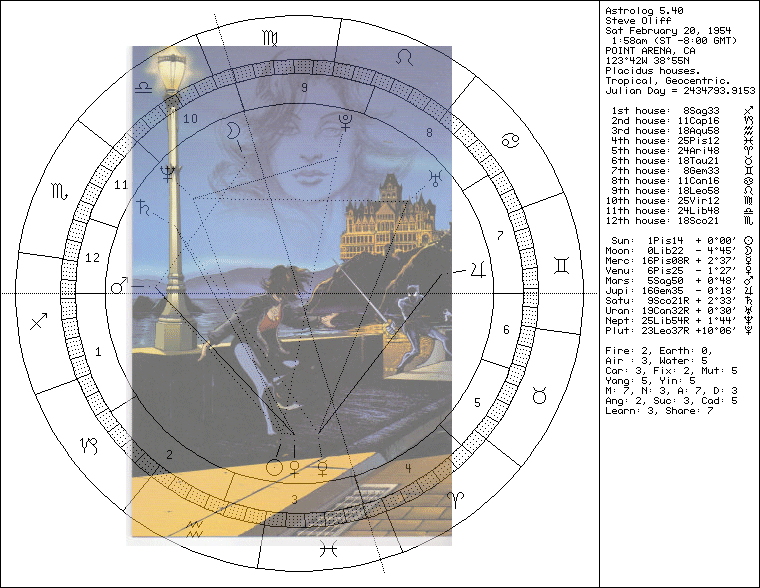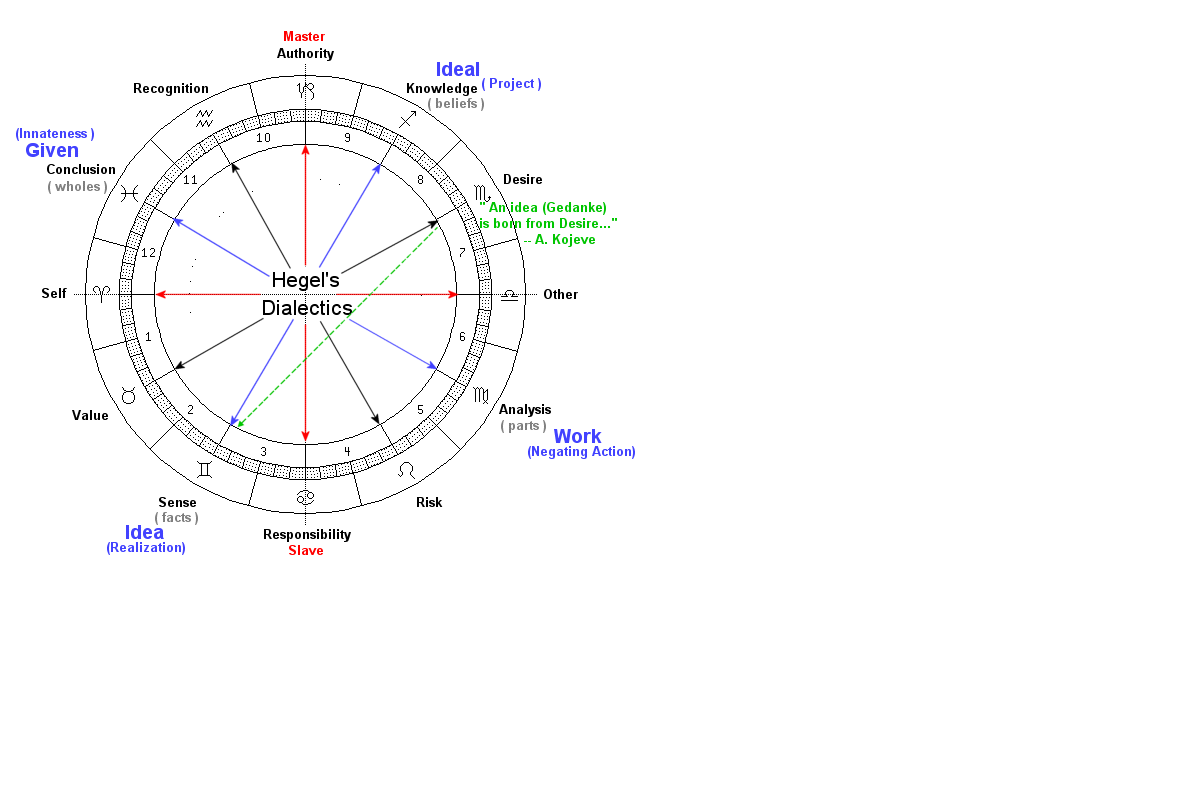Even though I think I am in near total agreement with Roland Barthes , "The Death of the Author." (Image, Music, Text. Ed. and trans. Stephen Heath. New York: Hill, 1977) ,
I am very reluctant to concede the non-existence of an identifiable individual person who performs the role of the author in his/her individuated manner. In short, literary assemblies of words are not, or may not necessarily be, reliant upon an individual author for their individually transcendent meaning, or their perpetual symbolic societal existence as preserved acts of language. However, the Identity of the person performing the "author function" remains a matter for astrology to define, discover, and (if necessary) recover. The maw of society's materialistic, humanistic, blank slate-preaching, individuality swallowers is ever gaping! And here, by identity, I mean that pattern of recognizable individual human potentials which comes to us in symbol form only by way of the art of astrology, and its very basic idea, the individual birth chart--that which plots the planets of the solar system and the angles of each relative to the others. These birth planets in aspects can be shown to be as if , for the purposes of critical analysis, algebraic formulations of human; references, perceptions, desires, and intentions peculiar to a
given artistic expression and its 'author'. Art's perceivers can use astrology to identify an author in terms of his/her birth chart pattern, if they will but also learn the basic vocabulary of modern Western astrology.
By way of specific example of how to introduce empirical evidence into a realm previously considered to be completely dominated by revelatory subjective perceptions, I have the following example which was prompted by a recent email exchange with a skeptical person wholly uniformed about the nature of what I call Horoscopic Expressionism (--the unconscious natal chart patterning of one's creative/artistic self-expression). As much as practically no intelligent person wants it to be true, something very like astrology exists in the human psyche. To show its presence, we can actually form testable hypotheses which are completely fallible,
falsifiable--'predictions' which can be dead wrong...or, we shall see, can be dead right. But at no time are you going to witness a magic act, you, the reader, are going to have to be interested in, at least mildly interested in, art, literature, humanity, and the unconscious nature of individuality; and, you will have to be willing to work at appreciating/understanding the relevance and the importance of the following example. Nobody gets it for free... : )
Here is the some email text which stimulated this blog post:
"[..] I think I responded way too hastily to your last message. Sorry. I will get back to you on this. You have given me a lot to consider.My belated, quasi-Hippie experience may have scared me into letting the Establishment build it's walls around me. And, in fact, I may have gotten out my favorite spackling tool and helped it. I'm thinking _One Day in the Life of Ivan Denisovich_. Remember that book? [..]"And my (edited/rewritten) reply to the stimulating email :
No, I have never read the book, but we can read a short summary from Wikipedia:
http://en.wikipedia.org/wiki/One_Day_in_the_Life_of_Ivan_Denisovich
from the Plot Summary:
"[..] The rest of the day mainly speaks of Shukhov's squad (the 104th, which has 24 members), their allegiance to the squad leader, and the work that the prisoners (zeks) do—for example, at a brutal construction site where the cold freezes the mortar used for bricklaying if not applied quickly enough. Solzhenitsyn also details the methods used by the prisoners for survival; the whole camp lives by the rule of survival of the fittest. Tiurin, the foreman of gang 104 is strict but kind, and the squad grows to like him more as the book goes on. Though a "morose" man, Tiurin is liked because he understands the prisoners and he tells them a lot and does a lot to help them. Shukhov is one of the hardest workers in the squad and is generally well respected. Rations at the camp are scant, but for Shukhov, they are one of the few things to live for. He conserves the food that he receives and is always watchful for any item that he can hide and trade for food at a later date. [..]So, by now, even professional astrologers are likely as not to scratching their heads trying their level best to see what I might be thinking about here as we read the summary (above). To explain--this is the point at which we enter into the analysis phase of the astrological-literary criticism task at hand. The goal here is for us to somehow see evidence of an identifiable 'author' of the text , here simply referencing a text which is merely describing a text for us on the basis of its redacted imagery--its excised idea content alone is our sample! The specific record a particular act of human ideation, itself, is the piece of the individual author we now are holding here in our hand for close reading and translation.
To detect the presence of an individual author we have to translate his idea/word picture into astrological symbolism. We must turn meaningful words into a similarly meaningful, (but algebraic), symbol figure which is comprised of at least two astrological planets appearing to us as probably being in a specific angular relationship to one another. In short, we must convert English prose snippets of metaphor and metonymy, into an analogous statement in the language of astrology.. into astrolog-ese. The writer's literary tokens, which are meant to symbolize expandable ideas, must themselves be conjured up in our mind as similarly expandable/extendable symbols found in planet/aspect 'algebra'. This is an algebra of qualities, not quantities, but because the planets positions relate to specific date and times of day, the dimension quantification is not lost. Once we make an analysis, decide on what planets are situated thus and thus to one another, we automatically introduce the dimension of chronological time, and thus the capability of objective measurement concerning the validity or falsity of our perception and deductions. We can make a testable hypothesis measured in terms of ordinary units of time, as in any other science.
<>
No, I have not read Aleksandr Solzhenitsyn, but I just did the Wiki search for a summary, and found the reference of brick and mortar construction--the mortar freezing before bricks being laid, if not quickly accomplished, and the parallel symbolism of prisoner solidarity, the difficulty of necessary bonds being likewise quickly over come if there was to be a general hope of survival through constructive behavior.
My mind often leaps to analytical, literary tropes, before I finish reading the brief descriptions of such expressions. I grasp the analogy in its many variations whether I want to or not, like an asperger's case I guess. I see symbolic formula equivalents in 'astrolog-ese'. I make a hypothesis to test.
In this instance I was promptly excited about the sense of an inverted simulacrum (the word used correctly I hope) in the art and person of Robert Frost--perhaps best symbolized in a holistic manner by his poem, "Mending Wall"
How these two authors are similarly unconsciously organized such that they are successfully expressed by this trope , this wall/construction analogy/metaphor, goes to my sense of the individuated existence of an author/the authors. If the perspective of the observing critic here is guided by a desire to see these authors using this creative act as a means to a substantial symbolic existence (ek-sistence), then said observer must also conclude from the privileged viewpoint of one immersed in literary 'astrolog-ese' (as living linguistic real), that the first deduction leading to a testable hypothesis is that these two authors may be expressing the same astrological referents, (Saturn as form, bond, construction and wall: Uranus as both Promethean creative invention, and the dis-uniting capability of any agitating chaos) . So the mind can hypothesize that we are looking at Saturn and Uranus in a cooperative dialectic..yet somehow in an inverted form from author to author.
Frost's wall and the poem's intentions are a part of my experiential vocabulary, and rapidly I remember, see, in my mind Saturn opposite Uranus ...I hear it "speak" from the unconscious of the author--from his Identity, not his Id or whatever...(don't really know the specifics of the difference(s) I'm intuiting here). But anyway,
Individuality is the product of a combination of genotypic and phenotypic identification potentialities being manifested, here, as artistic Self-expression . ( I am thinking of the Self as like the astrological natal chart very abstract and not comparable to self, which , to me, seems more like personality than as pure potentiality.
I here illustrate what I 'see' as key to understanding the new author by way of the one already experienced.
Partial natal chart of Robert Frost illustrating my sensing the presence of an astrological tropism:
http://pedantus.free.fr/Frost_R_001a.gifThis graphic shows Saturn opposite Uranus. This potential of Frost' is voiced in his introductory lines of
"Mending Wall""[..]SOMETHING there is that doesn't love a wall,
That sends the frozen-ground-swell under it,
And spills the upper boulders in the sun;
And makes gaps even two can pass abreast.[..]"
Uranus as chaos threatens the permanence or stability of the stone wall structure , = Saturn. But as we read the poem we discover the intentions of the author to say that this is probably nature's way of showing us we are probably wrong to build walls between neighbors anyway--the chaos is a just intervention of the world's unspeakable wisdom. Well, at least the poet, Frost, suggests something like this view of nature's 'frost' performing with intentions to take down the wall. Saturn as authority imposed arbitrarily, and all sorts of nuanced themes with that flavor are suggested as existing in the Real of life.
So the hypothesis is that Solzhenitsyn also may have his kernel of inspiration in the form of Saturn opposite Uranus. We can objectively test this up until know wholly subjective revelatory awareness. And, before I forget to mention it, this experience was fully conceived in my mind before finishing a small impatiently scanned potion of the novel's Wiki summary.
Aleksandr Solzhenitsyn:
graphic illustration:
http://pedantus.free.fr/Solzhenitsyn_A_001a.gif
The timing of these two births separated by four decades is such that they show the inversion of the Saturn opposite Uranus astrological trope. Now the building of a wall is not about merely separate and reluctantly cooperative neighbors we find in Frosts poem. Saturn now in Aquarius (the opposite of Frost's Uranus in Aquarius) is the inversion of the societal relationships--a negative image appearing in the reversal--no longer about a contentedly independent farmers communing at a negligibly necessary task of wall building due to their contiguous physical and social circumstances. In the inversion from Frost to Solzhenitsyn we see forced labor, in a gulag, working quickly to keep mortar from freezing, and persons only cooperating under complete duress--persons suffering a 'society' restricted to limitations of survival of the fittest and canniest. [..] "
With just a little experience and an open mind, I think it is easy to detect the 'feeling' and subsequent mental image of Saturn opposite Uranus, which comes to me quickly when reading the summary of Solzhenitsyn's plot. I think it is easy to remember Frost's poem...what he meant to say and why he says it...easy to remember that he was born with Saturn opposite Uranus (thus Solzhenitsyn logically should have been born with just such a figure in his natal chart) and how those birth planets are expressed as a slight chaos of frost heaves and unsettled boulders atop walls , and the rocky relations with reluctantly social neighbors. In all of this I could be so completely unimaginably mistaken, but to me, I just see academic intellects avoiding this rich understanding of humanity simply because of some kind of totally unfounded metaphysical bias. Individual identity as a function of the dreaded art, astrology, is not hogwash or superstition if we can measure phenomena in terms of rational units of time..this horoscopic expressionism, for want of another term, is the objective, empirical , scientific, observation of a human psychical phenomena.
Rog

 __Steven Pinker's graphic places his idea of purpose on top, "up," because the mind's unltimate goal, ala Pinker, is to converse--to emit speech form the mouth and detect it withe the use of the ears. But notice that "Semantics," our personal meaning, is likewise subject to the exact same motives that I cited in my graph, "Belief and Desires." I don't mind saying that seeing this did tickle me pink. I had used the traditional associations of the Zodiac Signs of Sagittarius (belief) and Scorpio (desire) to cite the same implicit structuring or coordination of motives. So, how does Steven Pinker's graph reconcile with my suggestion? Being that we came at this graphing task from two different purposes; mine more philosophical, his more biological and psychological, it turns our we are nearly upside-down mirror images in terms of the background of the unflinching pattern of the Zodiac. Note that because we ended up with a mirror image, Pinker's labels need to be reveresed to an awkward sounding "Desires and Belief" and "Ears and Mouth," in order to be technically correct Zodiac-ally. This reversing of terms phenomena we see here just stands to show that the Zodiac was traditonally conceived the way in which I show it, and that Pinker, himself totally unfamiliar with the Zodiacal frame's "unobserved" structuralism, nevertheless silently adheres in principal to basic notions of what-goes-with-what quite naturally!
__Steven Pinker's graphic places his idea of purpose on top, "up," because the mind's unltimate goal, ala Pinker, is to converse--to emit speech form the mouth and detect it withe the use of the ears. But notice that "Semantics," our personal meaning, is likewise subject to the exact same motives that I cited in my graph, "Belief and Desires." I don't mind saying that seeing this did tickle me pink. I had used the traditional associations of the Zodiac Signs of Sagittarius (belief) and Scorpio (desire) to cite the same implicit structuring or coordination of motives. So, how does Steven Pinker's graph reconcile with my suggestion? Being that we came at this graphing task from two different purposes; mine more philosophical, his more biological and psychological, it turns our we are nearly upside-down mirror images in terms of the background of the unflinching pattern of the Zodiac. Note that because we ended up with a mirror image, Pinker's labels need to be reveresed to an awkward sounding "Desires and Belief" and "Ears and Mouth," in order to be technically correct Zodiac-ally. This reversing of terms phenomena we see here just stands to show that the Zodiac was traditonally conceived the way in which I show it, and that Pinker, himself totally unfamiliar with the Zodiacal frame's "unobserved" structuralism, nevertheless silently adheres in principal to basic notions of what-goes-with-what quite naturally!

























